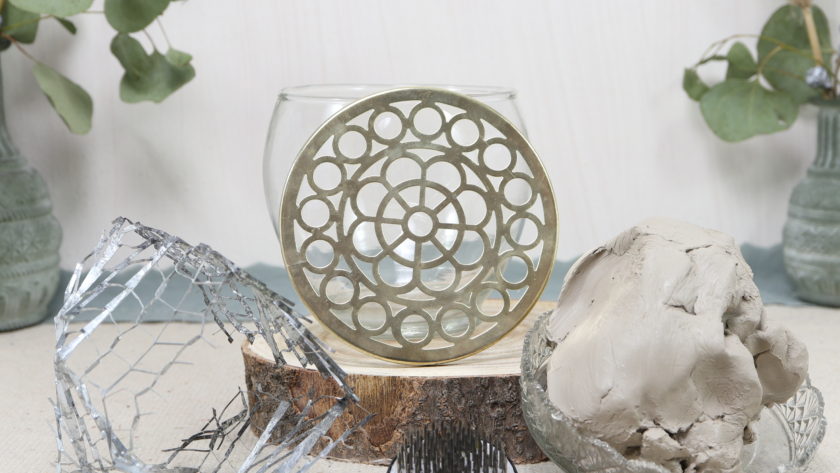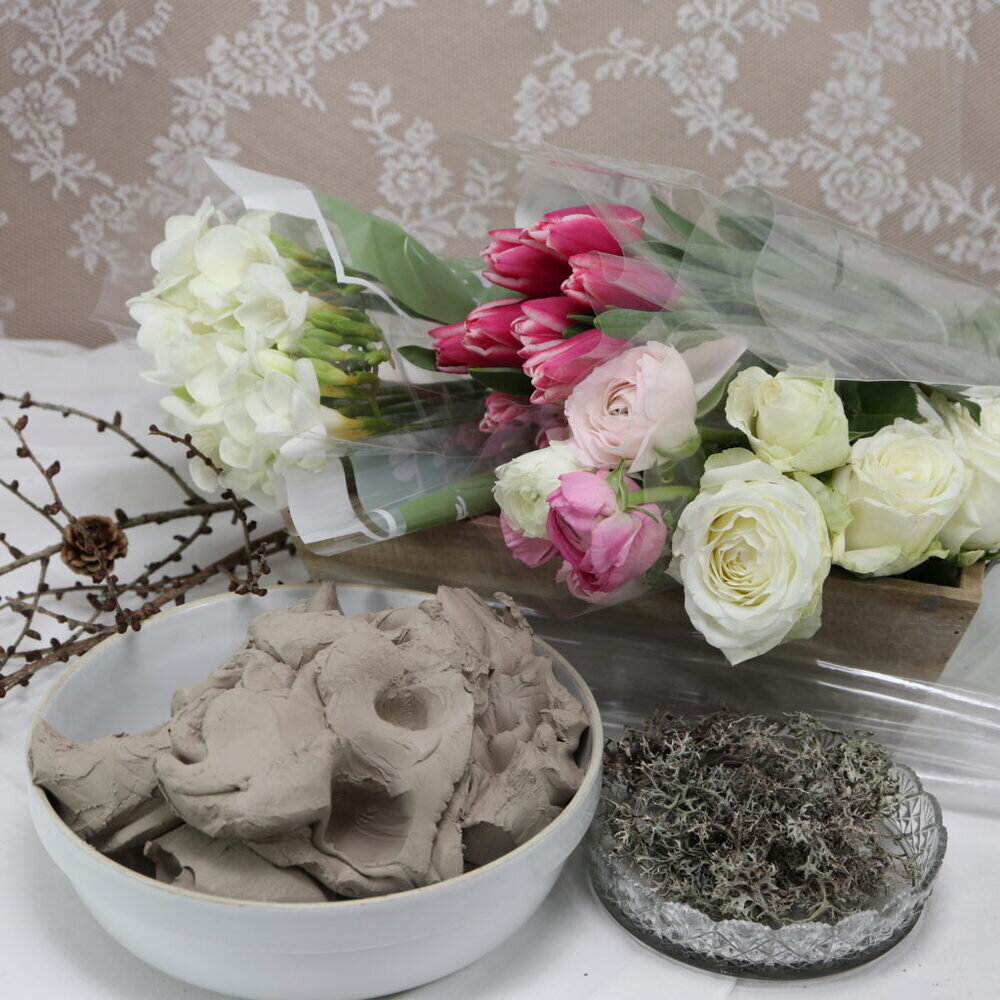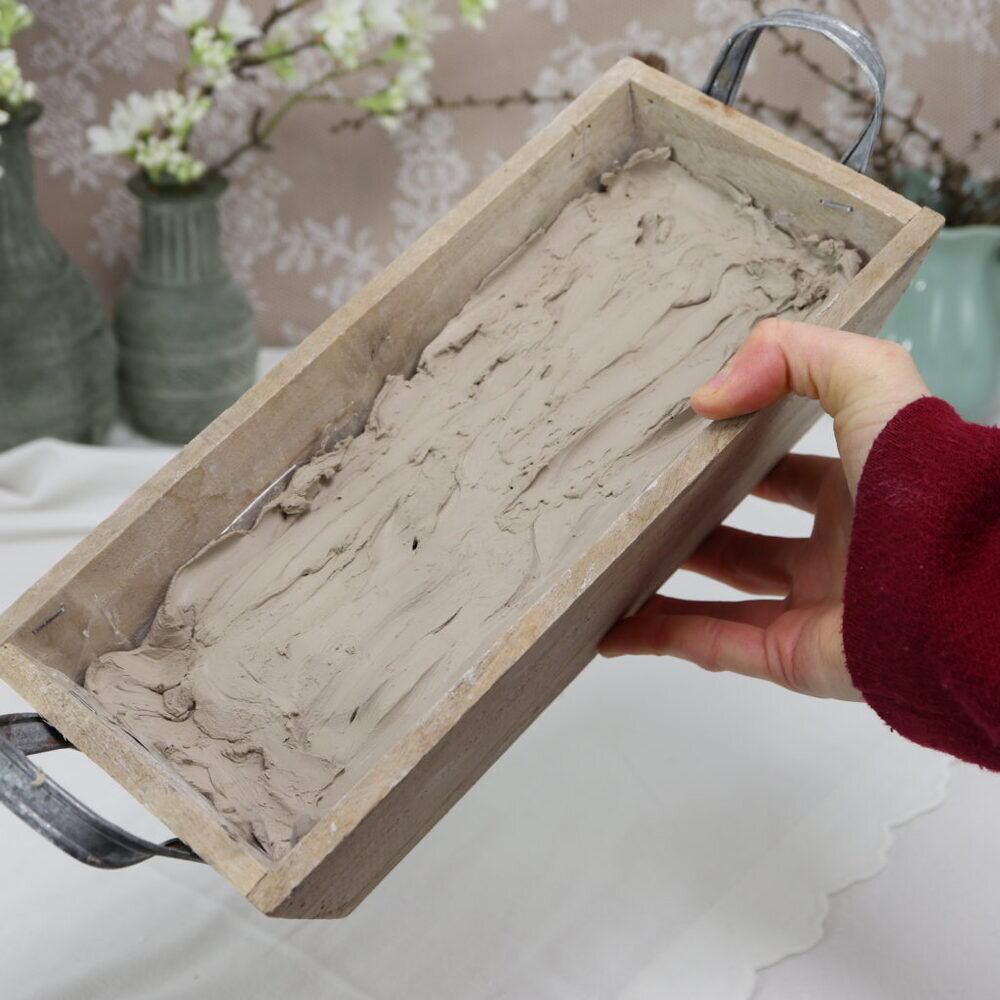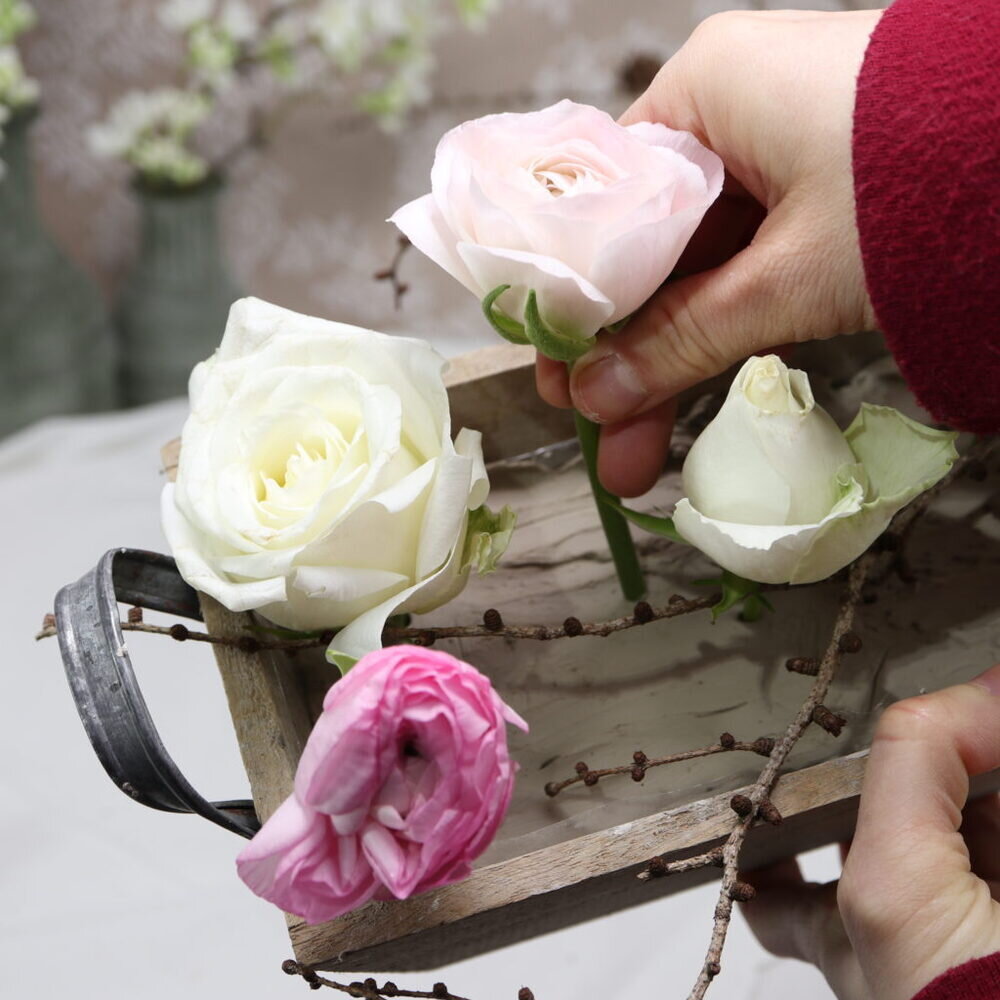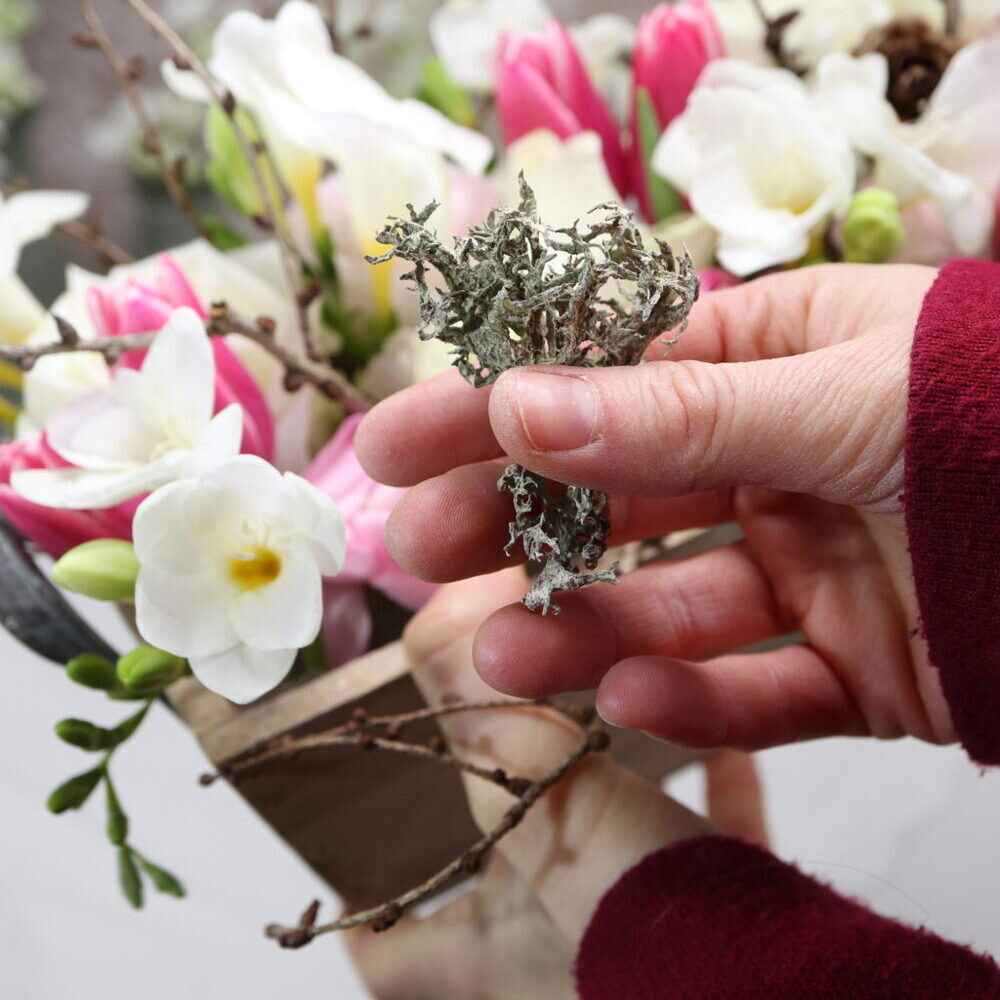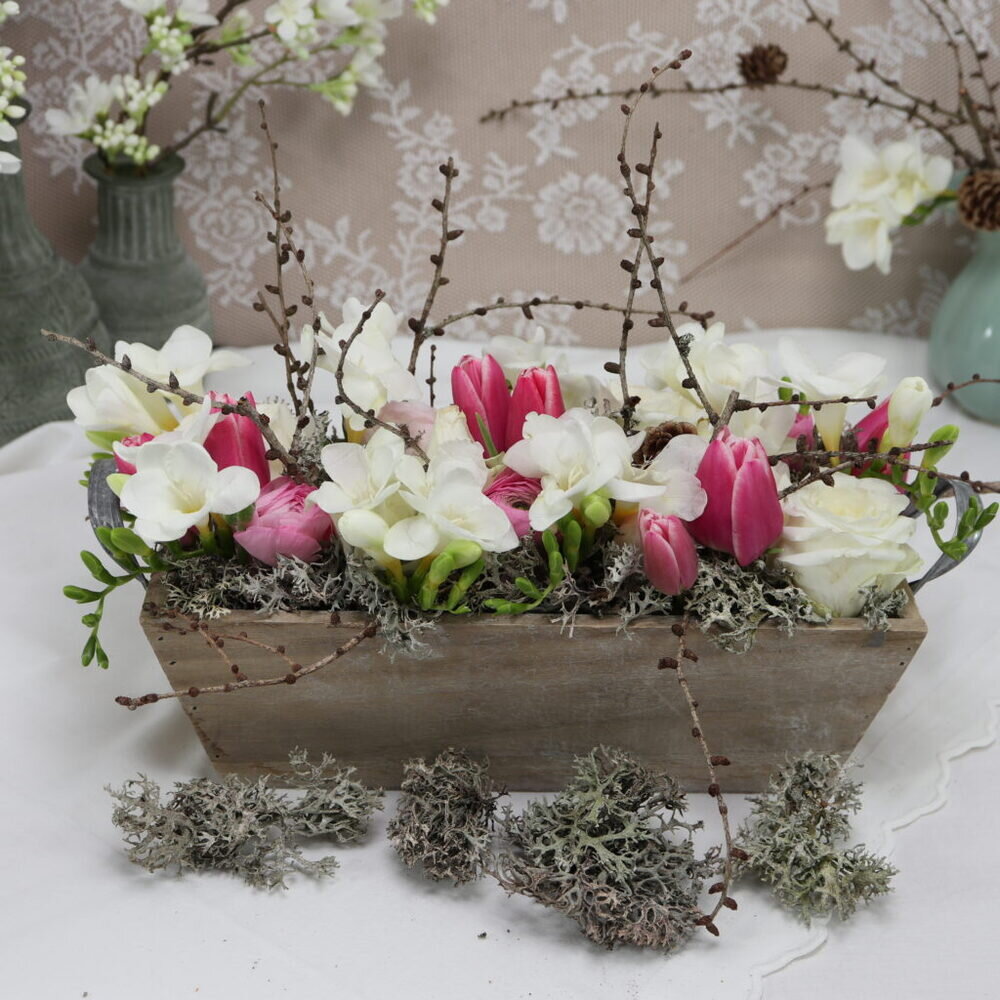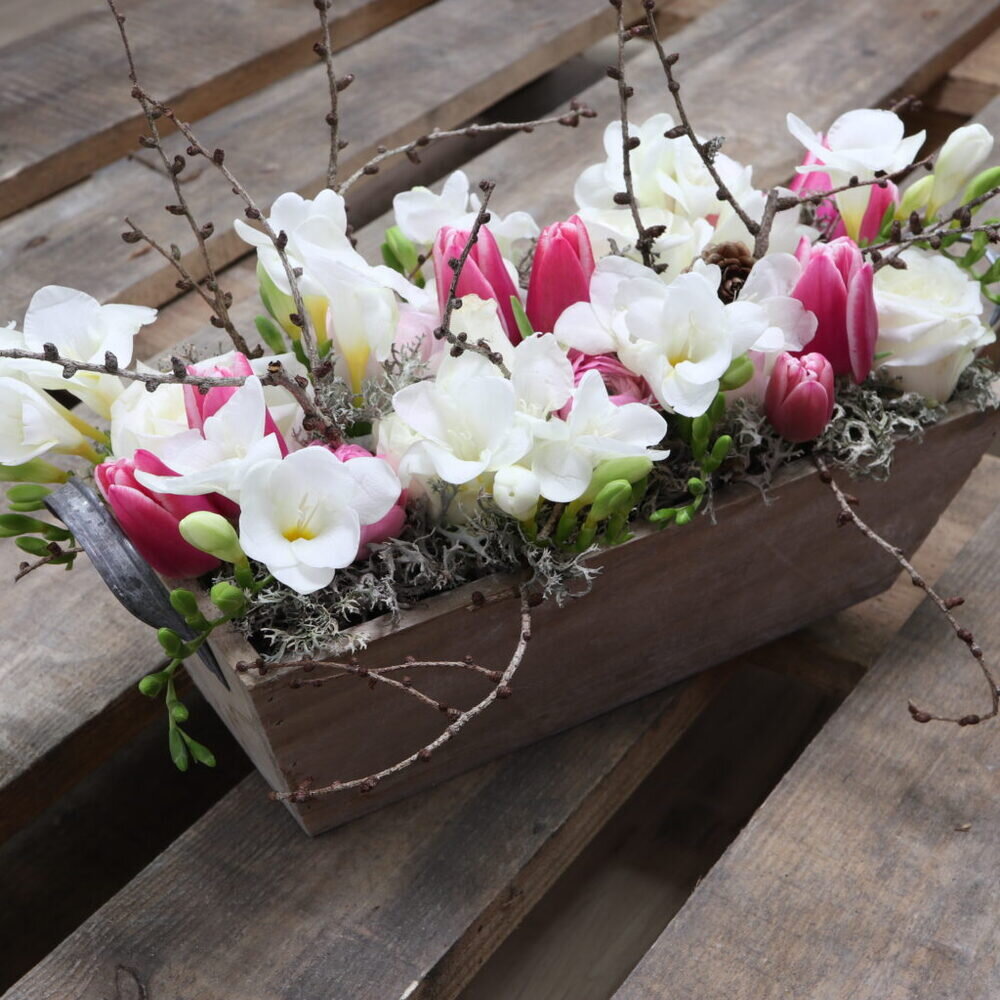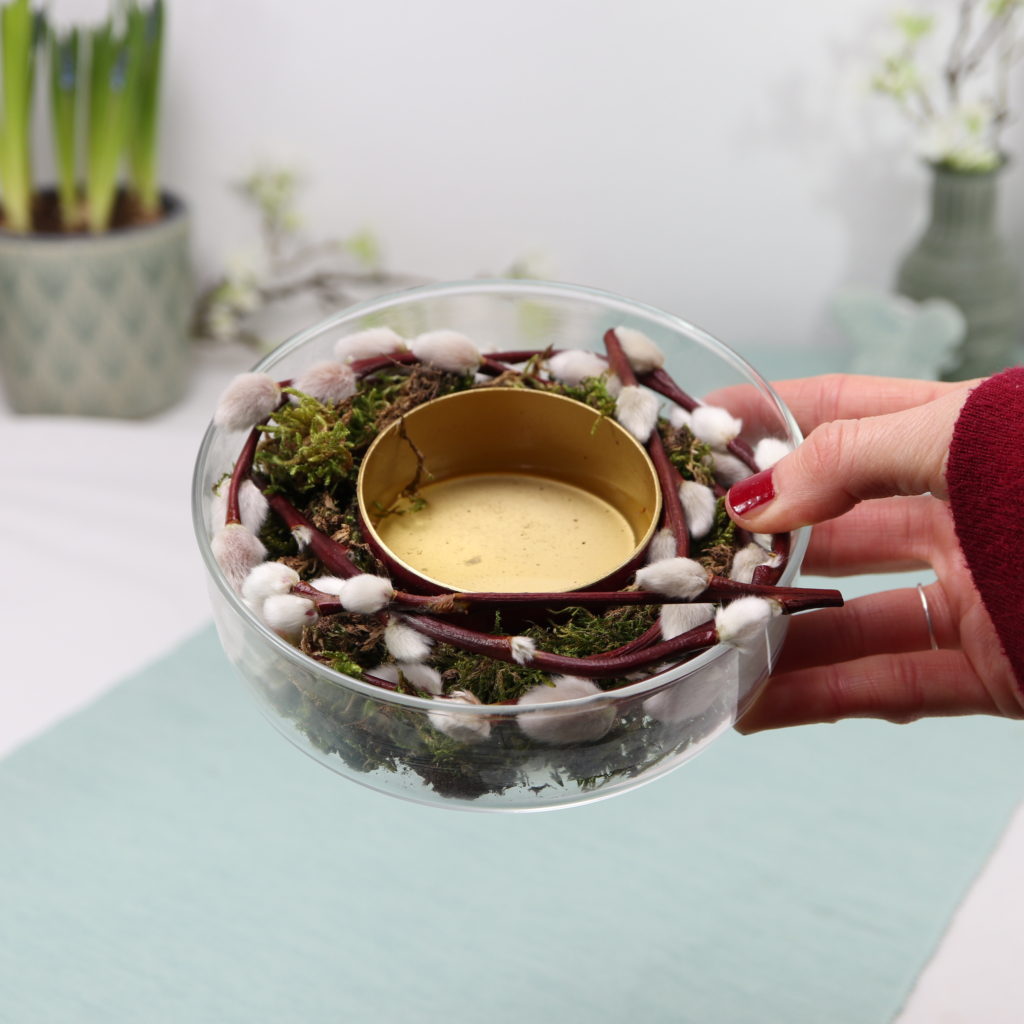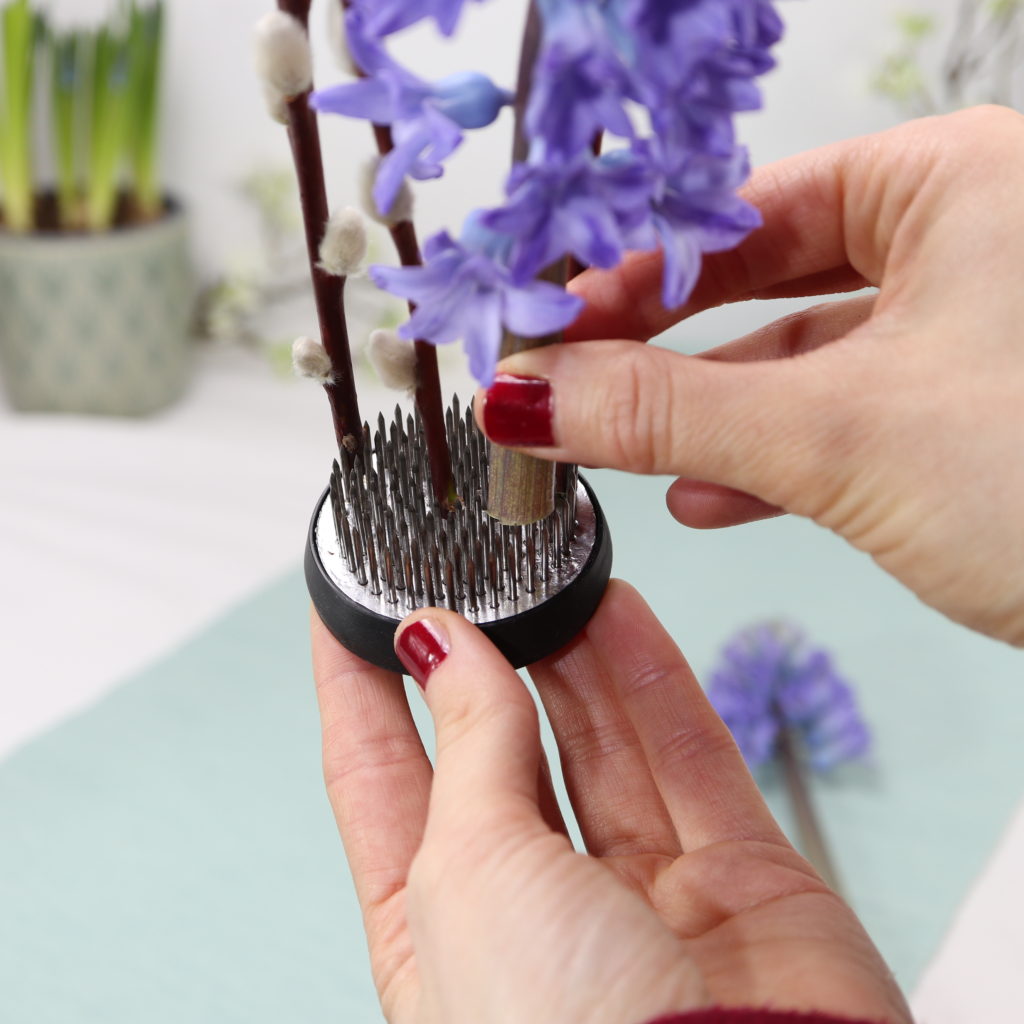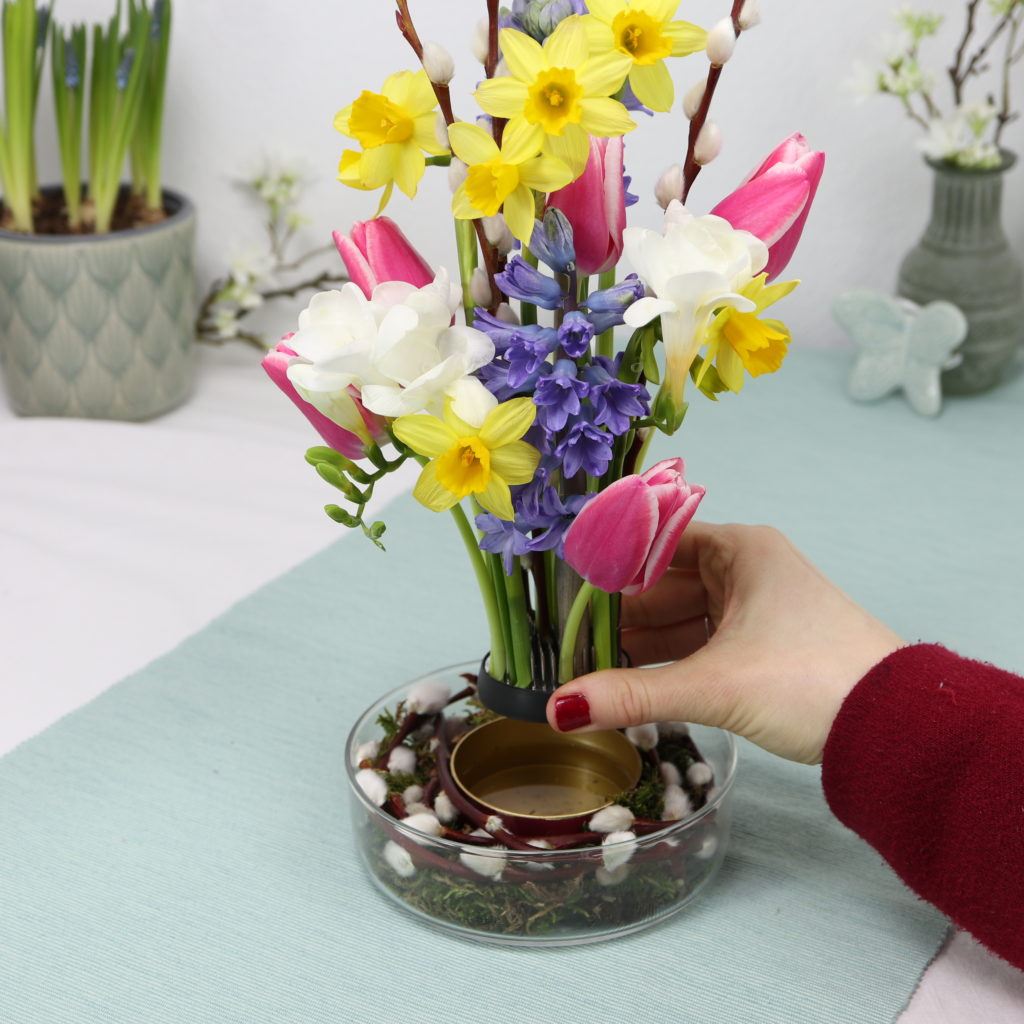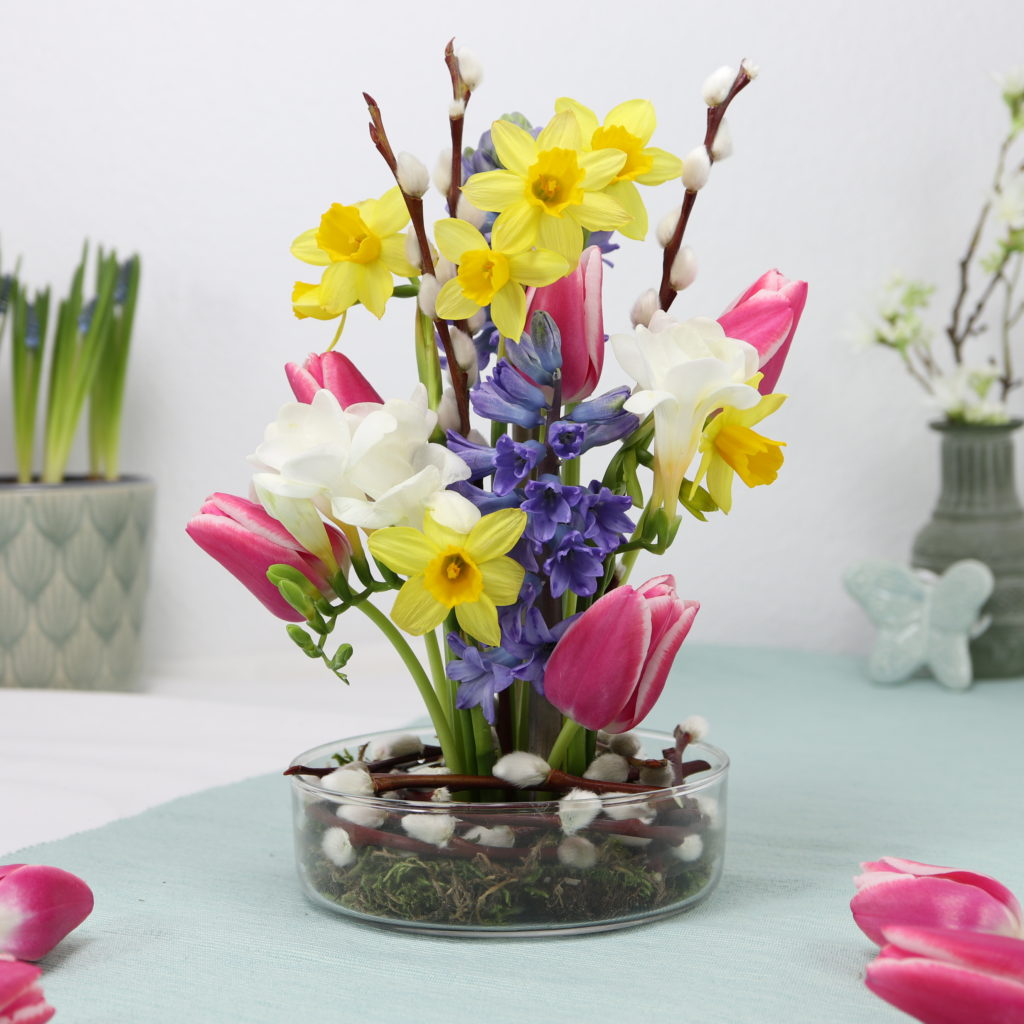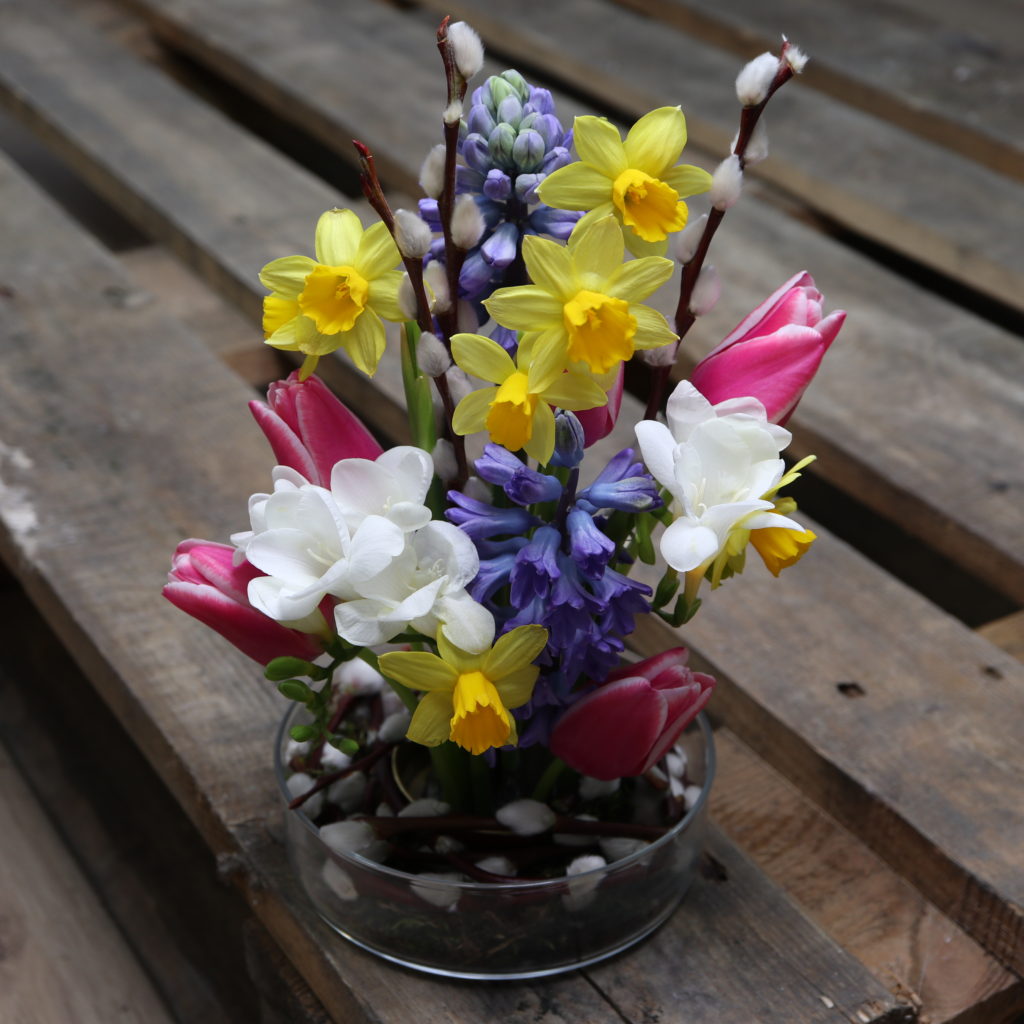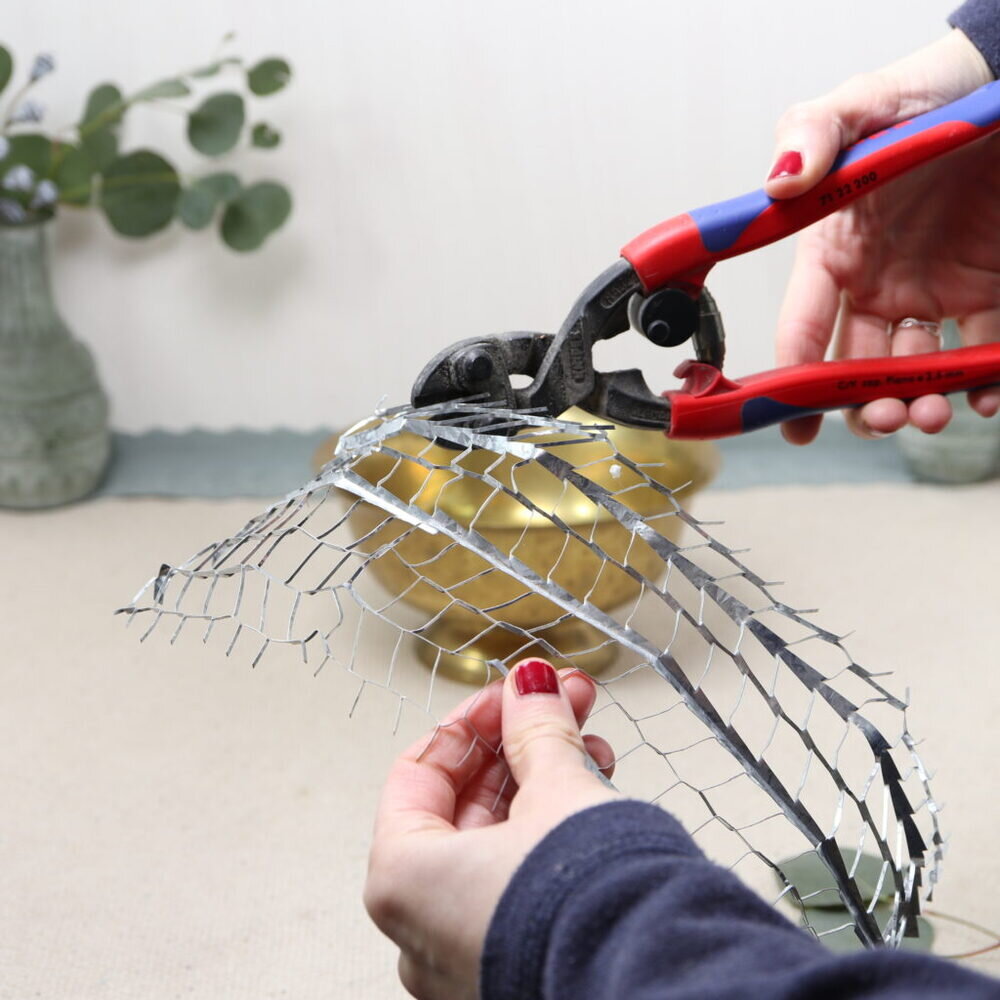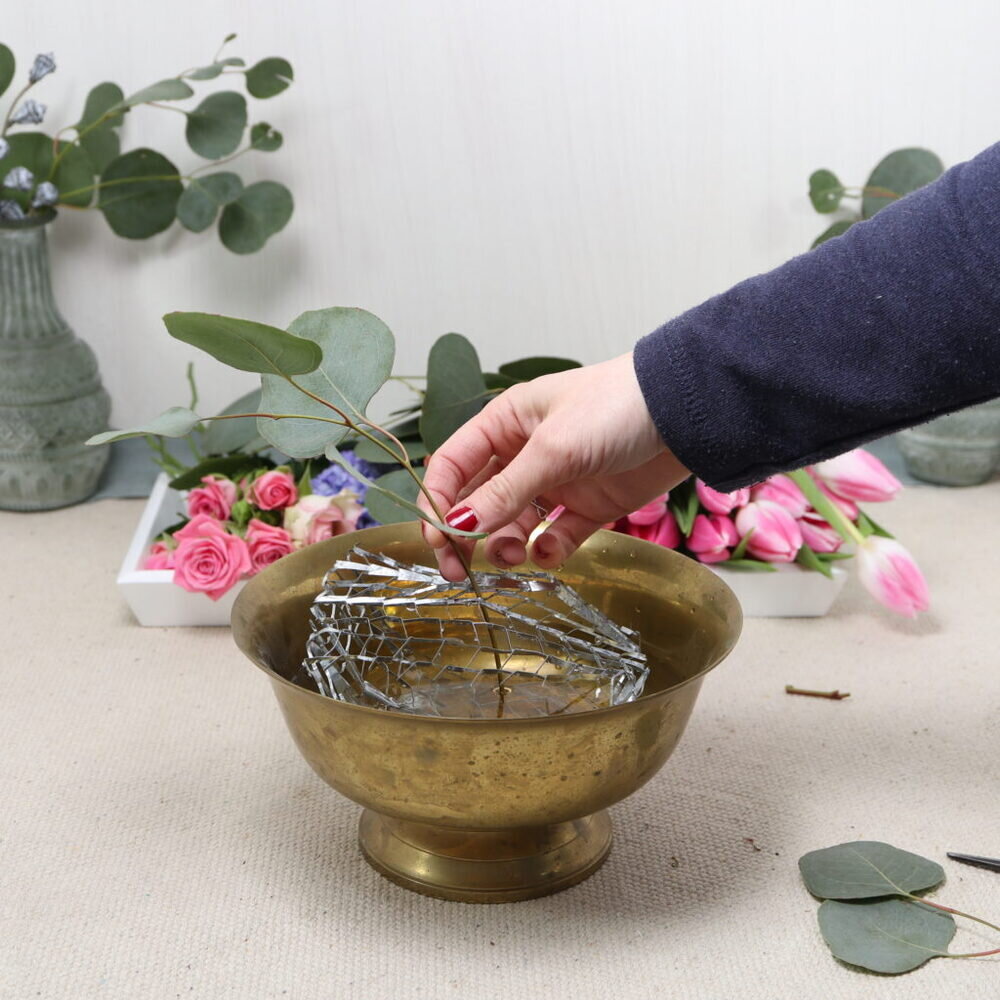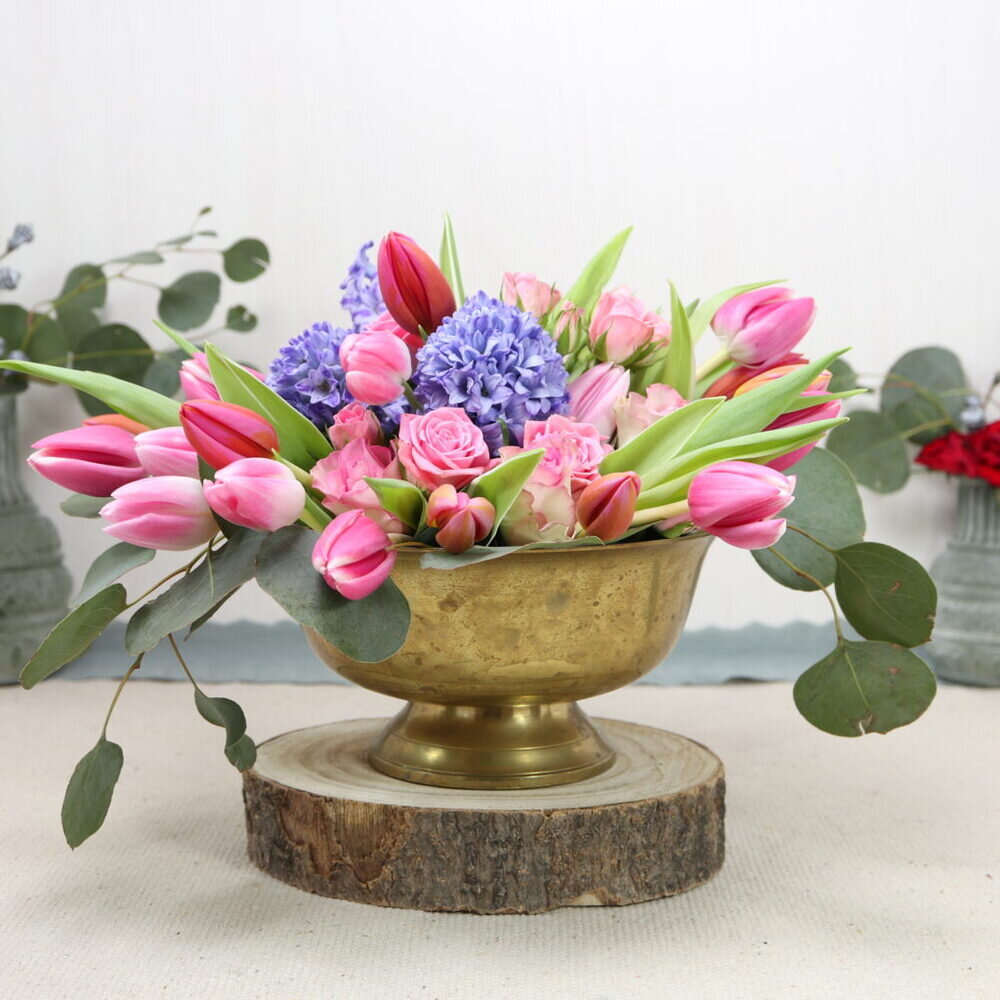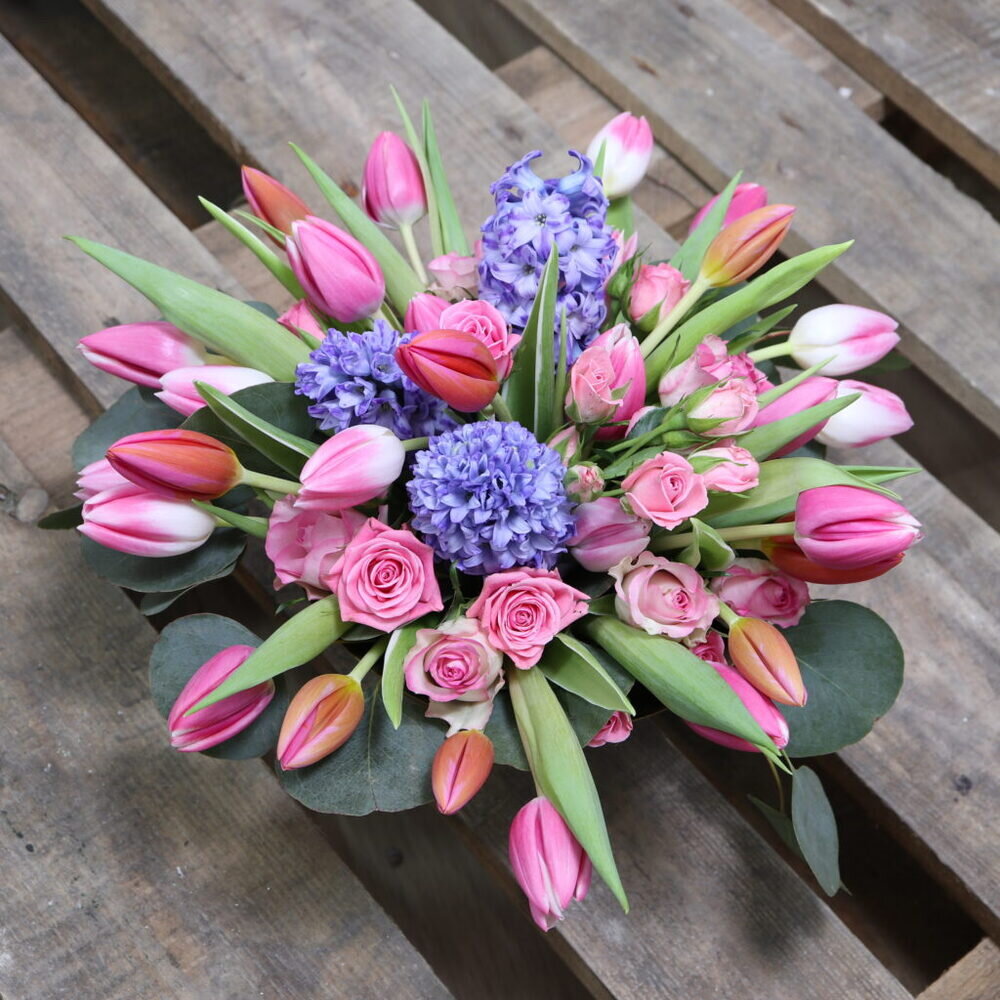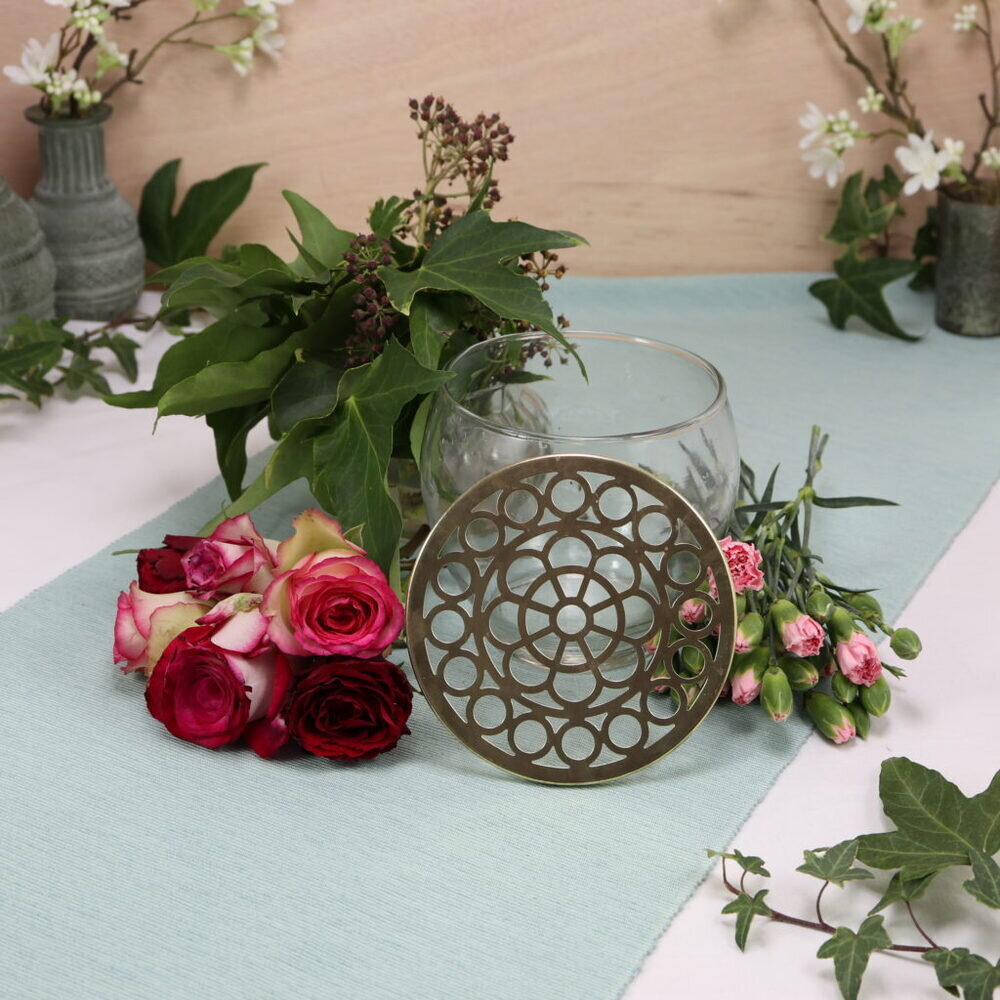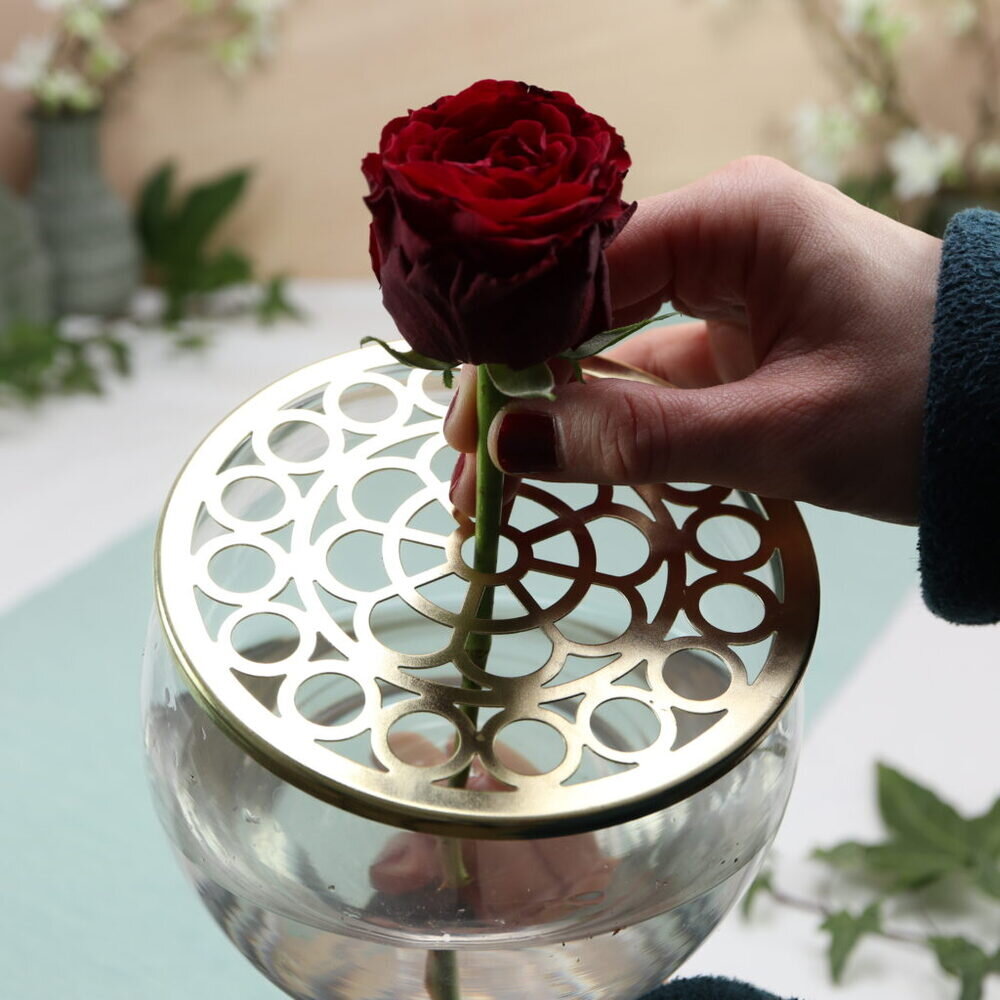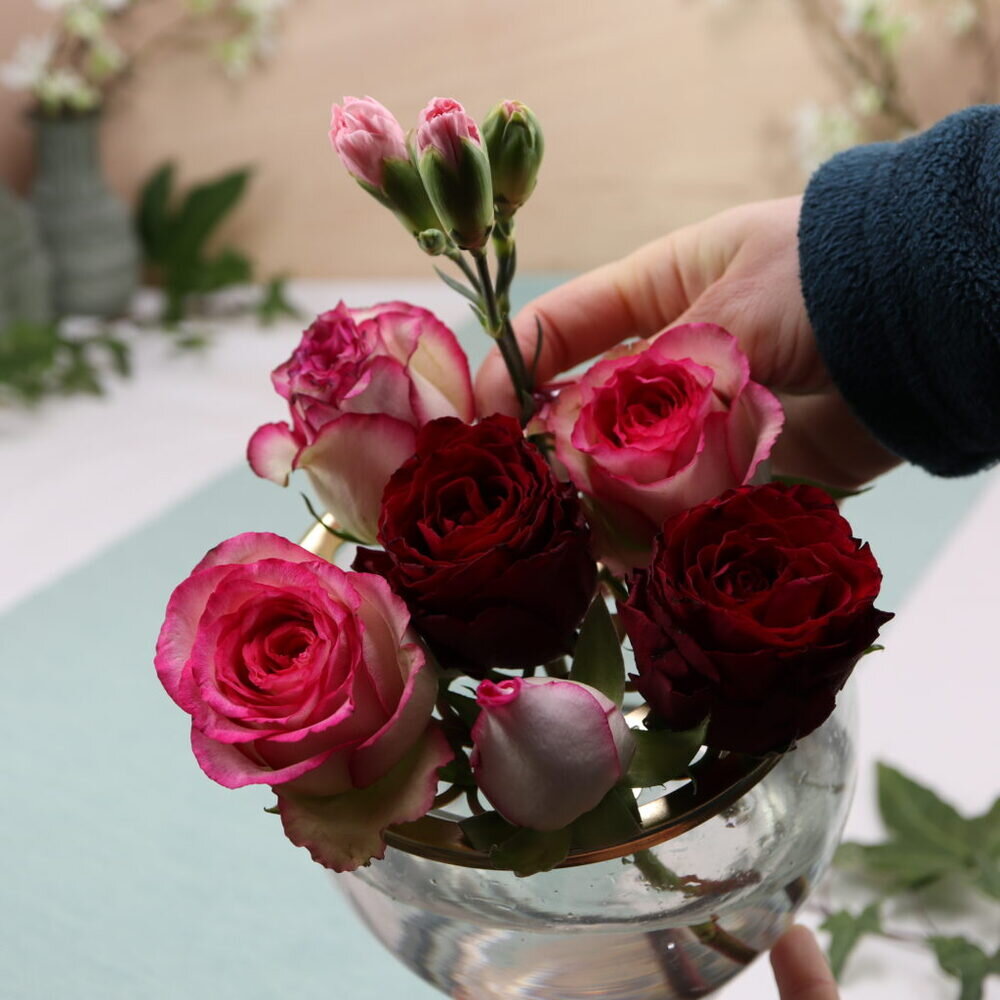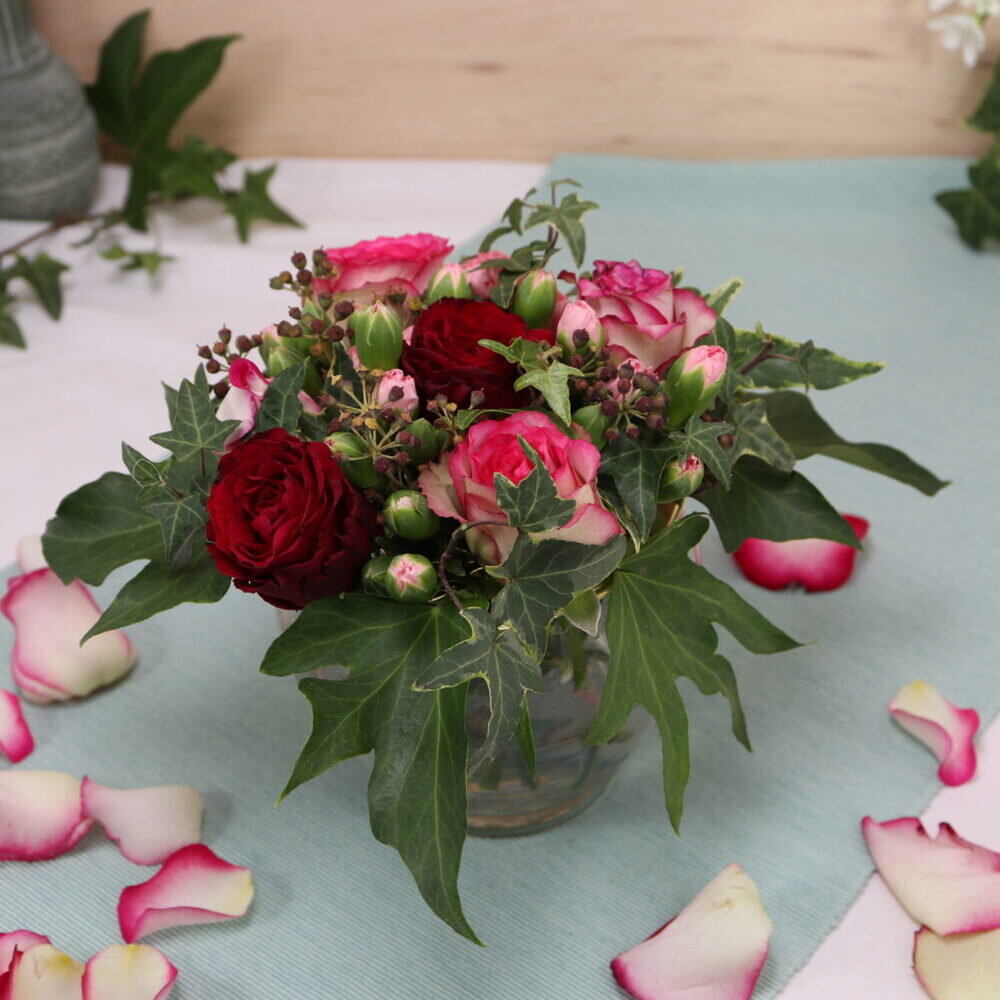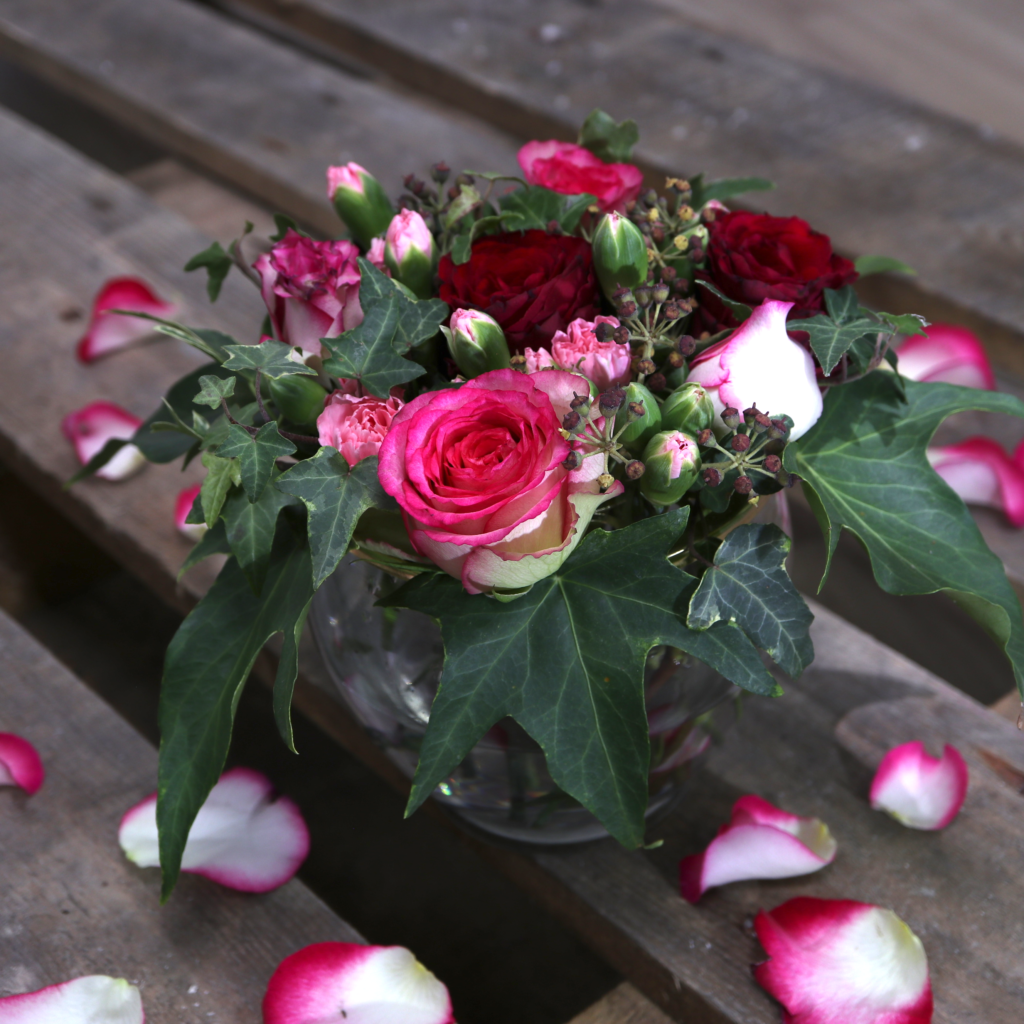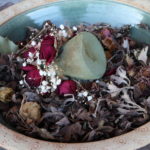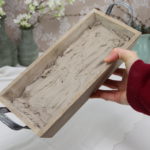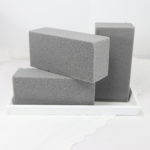In this article, I would like to share my experiences with “sustainable floristry”. In particular, I elaborate on alternatives to (artificial) floral foam. Floral foam is very often used when making flower arrangements. Unfortunately, floral foam is not very environment friendly, e.g. since it is a possible source for microplastics. Luckily, there exist more sustainable and environmentally friendly alternatives.
Floral foam for fresh cut flowers (wet floral foam) is indeed very practical and makes creation of flower arrangements very uncomplicated. However, floral foam is a synthetic resin foam that contains microplastics and cannot be reused. If you’d like to know more about floral foam, feel free to check out my FAQ on sustainability, disposal, microplastics, where I’ve answered common and frequently asked questions.
Let’s have a look at possible alternatives from sustainable floristry! I present the following alternatives:
- Clay
- Pin frog / Kenzan
- Wire mesh
- Vases with perforated covers/lids
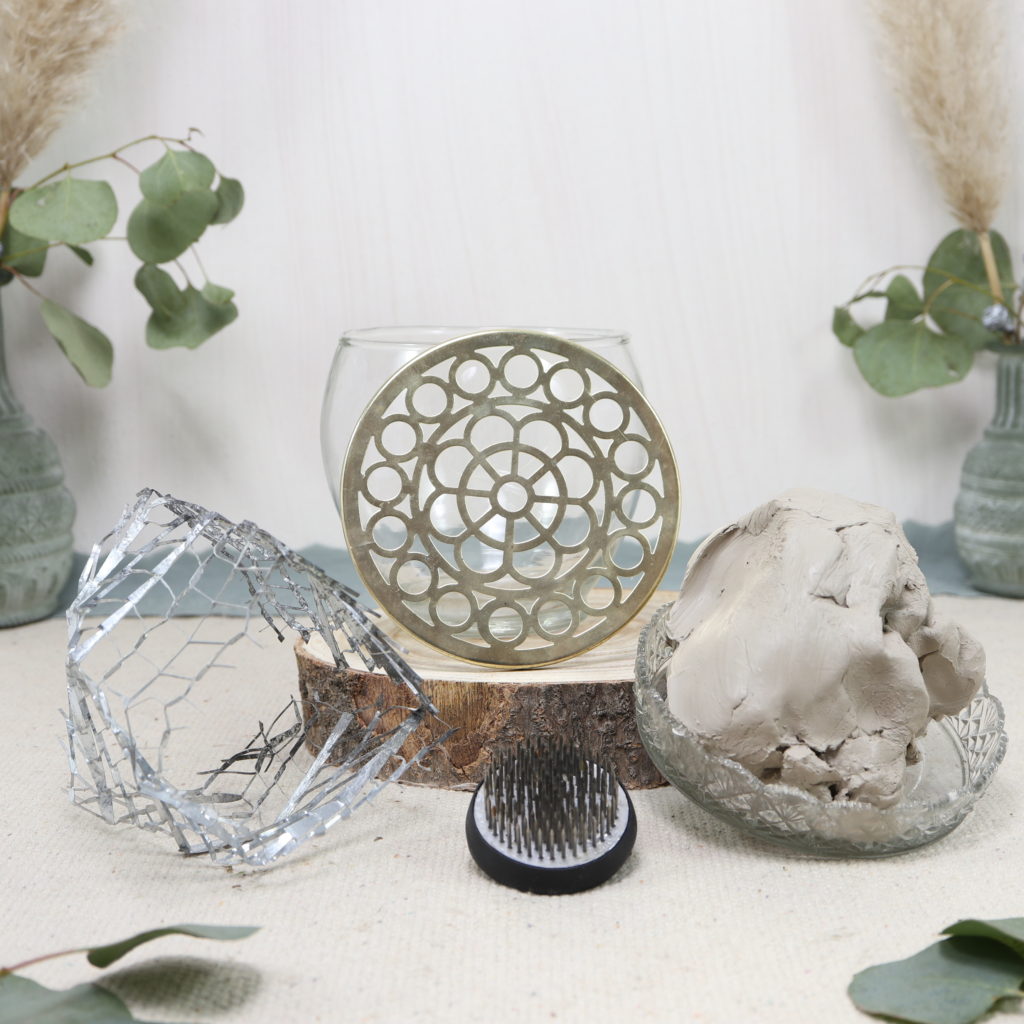
For each alternative I give you advantages, disadvantages and tips on what to look out for. In addition, I introduce you to each alternative a DIY idea with a detailed step by step instruction!
1. Clay
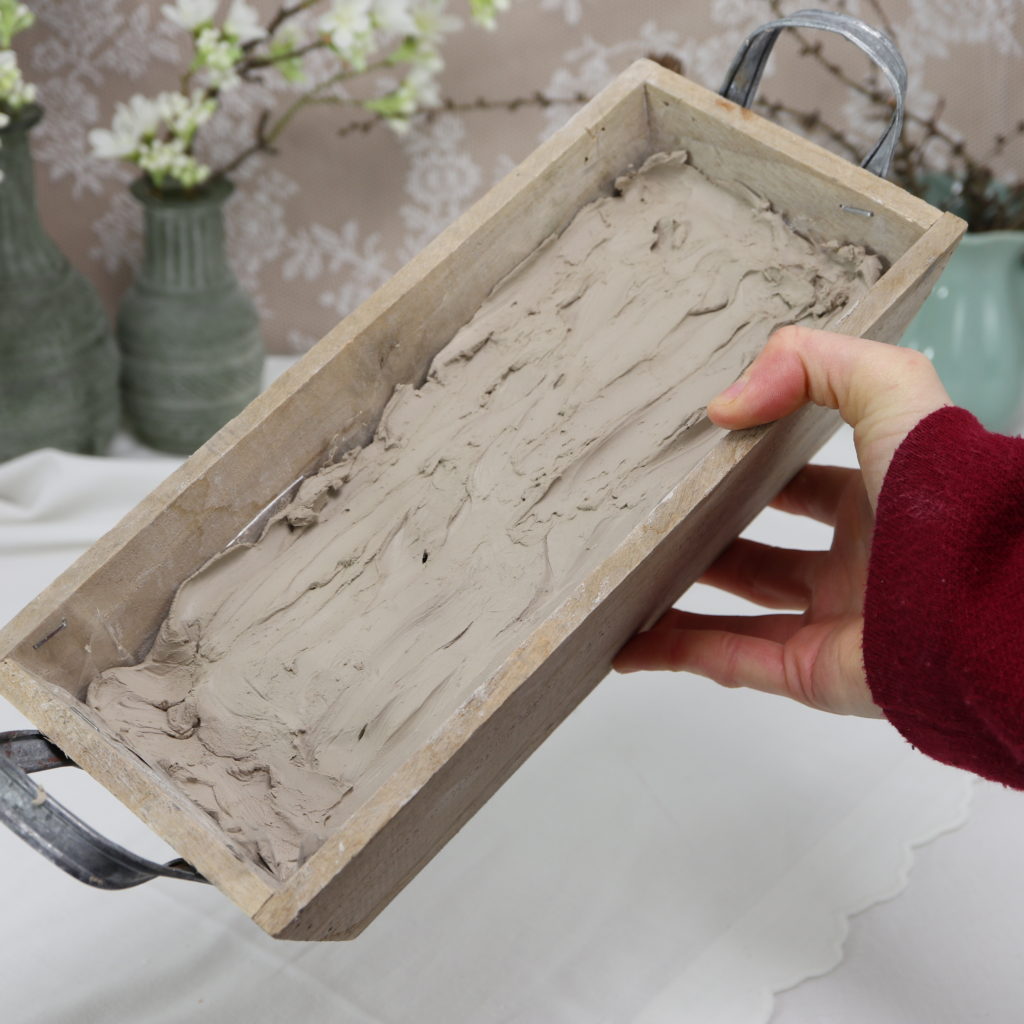
Clay is a natural material and can be used as a plugging compound to create flower arrangements.
Advantages of clay:
- Clay is of natural origin
- Working with clay is very simple: you put it in a container, smooth it out and simply put the flowers in. It is soft and does not require special preparation.
- Arrangements with clay stay fresh for several days. Many of my floral arrangements have lasted over a week.
- There is no need to dispose clay because it is reusable. Even hard clay can be softened by putting it with some water in a bag.
- Arrangements with clay are safe for transport, no water spills out. They are therefore also well suited as a gift.
Disadvantages of clay:
- When clay comes into contact with air, it can dry out and become hard (see tips below).
- Clay is most suitable for table arrangements in standing vessels. Unfortunately, hanging arrangements are difficult to make with clay, due to its heavy weight compared to floral foam.
Tips:
- Since clay can dry out in the air, I make sure that the entire surface is covered with fresh cut flowers when I make arrangements. This is achieved, for example, by moss or lichen which are perfect for filling empty gaps.
- In addition, I always add a little water to my fresh arrangement so that the clay remains soft and releases the water to the flowers.
- Storage of unused clay: Since clay dries in the air and becomes solid, it should be sealed airtight.
I have addressed general questions about clay and its use in flower arrangements in the FAQ: Clay as an alternative to floral foam.
DIY idea with clay:
I already created a DIY idea with clay as a step-by-step tutorial. In the tutorial, I show how you create a spring arrangement with tulips, roses, ranunculus, freesia, larch branches and lichen in a wooden box. You can find my DIY with clay as a plugging compound here: DIY | Alternative to plugging foam – spring arrangement with clay.
2. Pig frog / Kenzan
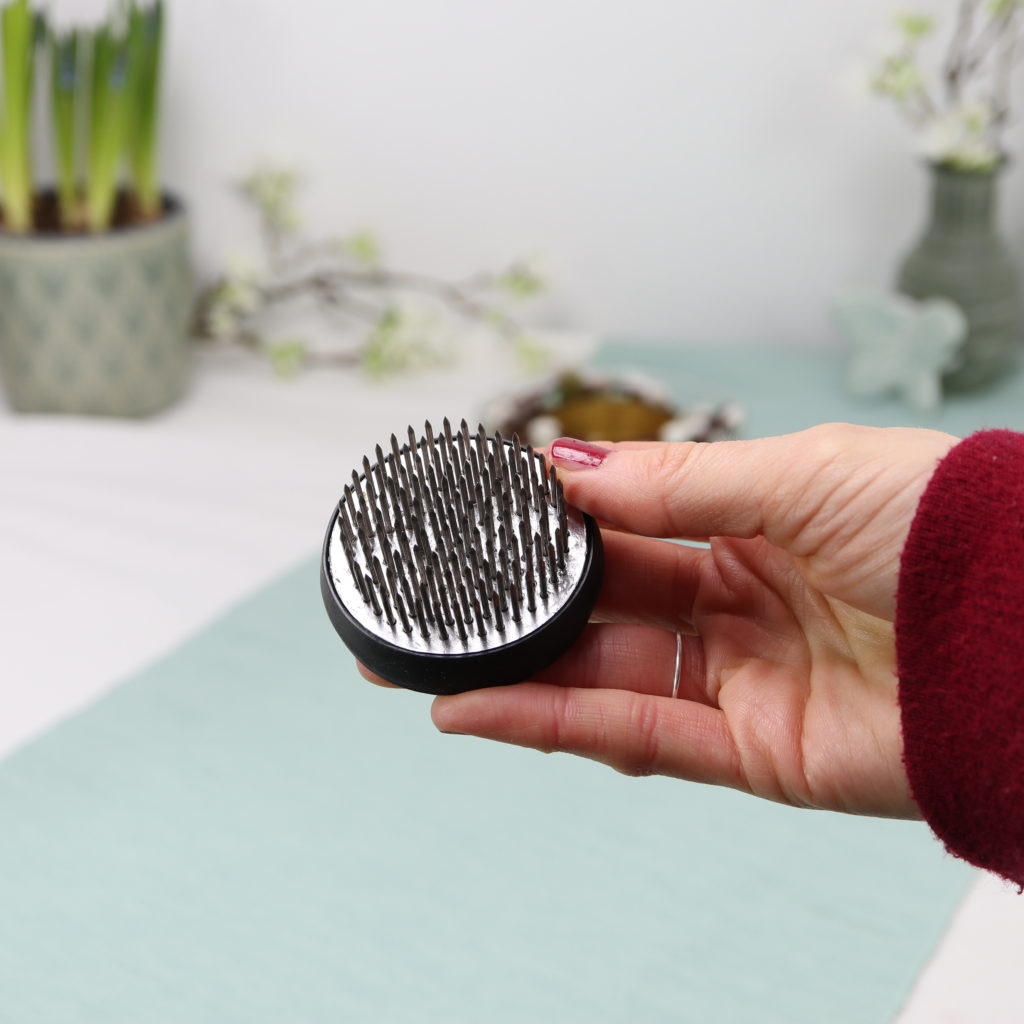
The pin frog, also called Kenzan, is a heavy round or square object with spikes made of small nails into which plant stems can be inserted.
Advantages of pin frogs:
- Working with the pin frog is simple: it is placed in a container, the flowers are simply put on the nails, and then water is poured into the container.
- The flowers can be supplied with fresh water.
- Pin frogs come in different sizes.
- The pin frog lasts a long time (especially if it is stainless) and can be reused.
Disadvantages of pin frogs:
- The pin frogs have a relatively heavy weight, so that it does not tip over with the inserted flowers. However, this makes it difficult to use pin frogs in hanging arrangements.
- Smaller plant stems can sometimes not be put on the nails of a pin frog.
- Finished arrangements are not always easy to transport, water can spill out. They are also not suitable as a gift, unless you want to give away the pin frog as well 🙂
Tips:
- The pin frog should be stainless.
- The flowers should be watered regularly.
- The pin frog should be cleaned immediately after the flowers fade.
DIY idea with pin frog:
I have already created a DIY with a pin frog as step-by-step tutorial. There, I show how to create a spring arrangement with daffodils, hyacinths, tulips, freesia, moss and willow catkins in a glass bowl. You can find my DIY here: DIY | Alternative to Floral Foam – Flower Arrangement with Pin Frog (Kenzan)
3. Wire mesh
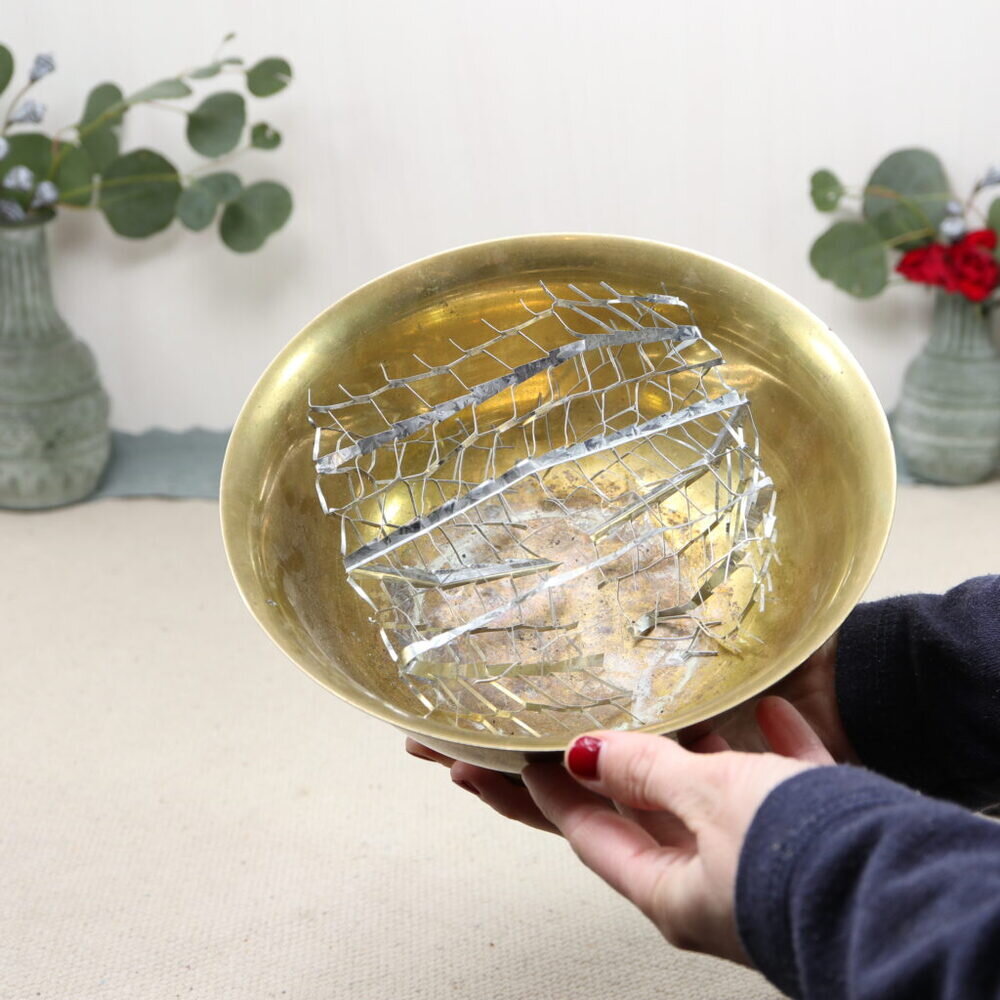
Wire mesh, such as chicken wire, wire mesh fence, or ribbed expanded metal lath, can also be used as aid for flower arrangements. When the wire is crumpled up, it gives a perfect flowers support.
Advantages wire mesh:
- Working with wire mesh is simple: You cut out a piece, crumple it and put it in a container with water. The flowers are put through the holes of the wire mesh piece.
- The wire can be easily formed to the shape of the vessel.
- The size of the holes can be easily adjusted to the width of the stem by cutting the wire mesh accordingly.
- The flowers can be supplied with fresh water.
- Wire mesh lasts a long time and can be reused.
Disadvantages of wire mesh:
- Sometimes the wire slips around in the vessel (see tips below).
- Finished arrangements with wire mesh are sometimes not easy to transport because of the water, unless you add the water later.
Tips:
- The wire mesh should be made out of stainless steel.
- If the wire in the container slips around, you can use sticky tape to hold the wire mesh in place.
- The flowers should be watered regularly.
DIY idea with wire mesh:
I already created a DIY with wire mesh as step-by-step tutorial. There, I show how to make a spring arrangement with tulips, hyacinths, roses and eucalyptus in a golden bowl. You can find my DIY with wire mesh here: DIY | alternative to floral foam – spring arrangement with wire mesh.
4. Vases with perforated covers/lids

Another way to arrange flowers are using holes of (perforated) lids or any other sorts of covers. Very often, the holes can be utilized to hold flower stems.
Advantages of perforated lids/covers:
- Working with the lids/covers is simple. They fit on different vessels and the flowers are simply put through the holes.
- The lids/covers are very stable and reliably keep the flowers in place.
- The flowers can be supplied with fresh water.
- The lids/covers last a long time and can be reused.
Disadvantages of perforated lids/covers:
- Finished flower arrangements with perforated lids/covers are not easy to transport because of the water, unless you add the water later. .
- Since the holes are already there, the holes might not fit to the stems size of your flowers
Tips:
- The flowers should be watered regularly.
DIY idea with perforated lid/cover:
I have created a DIY that uses a perforated cover and a vase. There, I show how to create a flower arrangement with roses, carnations and ivy in a glass vase with lid. You can find my DIY here: DIY | Alternative to floral foam — rose arrangement in glass with perforated lid
Summary:
In my experience with sustainable floristry, there are great alternatives to conventional floral foam that can be seen as more sustainable and environmentally friendly. Clay is maybe the closest to floral foam. The flowers can be pinned into the clay the same way as with floral foam. In fact, however, it is difficult to replace floral foam completely (for example, in hanging floral arrangements). Still, for many floral arrangement types it is worth, trying out one of the possible alternatives!
